Ijraset Journal For Research in Applied Science and Engineering Technology
- Home / Ijraset
- On This Page
- Abstract
- Introduction
- Conclusion
- References
- Copyright
Brand Churn A Significant Percentage of Customers Leaving for Competitors
Authors: Aabhas Rana, Rajesh Kumar Yadav
DOI Link: https://doi.org/10.22214/ijraset.2024.61412
Certificate: View Certificate
Abstract
Brand churn, characterized by a significant percentage of customers leaving for competitors, poses a substantial challenge for businesses across industries. To understand the underlying factors contributing to brand churn and devise effective retention strategies, a survey questionnaire method was employed. The questionnaire was designed to gather insights into customers\' reasons for switching brands, their perceptions of competitor offerings, and their preferences for brand loyalty incentives. A diverse sample of respondents representing various demographic segments and purchasing behaviours was targeted to ensure comprehensive data collection. The survey findings revealed key drivers of brand churn, including dissatisfaction with product quality, pricing competitiveness, and customer service experiences. Additionally, insights into customers\' perceptions of competitor brands and the effectiveness of loyalty programs in retaining customers were garnered. The results of this survey provide valuable insights for businesses seeking to mitigate brand churn by addressing customer needs and preferences effectively. By implementing targeted retention strategies informed by these findings, businesses can enhance customer loyalty, reduce churn rates, and maintain a competitive edge in the marketplace.
Introduction
I. INTRODUCTION
A. Background of the study
"In today's highly competitive markets, understanding and mitigating brand churn, or customer attrition, is paramount for businesses striving to maintain a loyal customer base and sustain growth. "Understanding Brand Churn: Analysing the Factors Behind Customer Attrition in Competitive Markets" delves into the multifaceted aspects influencing customer churn within competitive landscapes. This study aims to shed light on the underlying factors driving customers to switch brands or cease their patronage, providing insights crucial for businesses to devise effective retention strategies.
Customer churn, or the rate at which customers discontinue their relationship with a brand, is a significant concern for businesses across various industries, especially in highly competitive markets. The phenomenon of brand churn can be influenced by a multitude of factors, ranging from product quality and customer service to pricing, competition, and shifting consumer preferences.
Understanding the underlying drivers of brand churn is essential for businesses seeking to implement effective retention strategies and maintain a loyal customer base. By Analysing customer behaviour, feedback, and market trends, businesses can identify patterns and correlations that contribute to customer attrition. This study aims to delve into these multifaceted aspects, providing insights into the complex dynamics of customer churn within competitive landscapes.
Moreover, the study aims to explore the impact of various factors on customer loyalty and satisfaction levels, including product performance, brand reputation, customer service quality, and pricing strategies. By examining these factors in depth, businesses can gain a deeper understanding of their customers' needs, preferences, and pain points, enabling them to tailor their retention strategies accordingly.
Furthermore, the study seeks to identify potential warning signs or early indicators of customer dissatisfaction and churn, allowing businesses to proactively address issues and implement corrective measures. By leveraging data analytics and predictive modelling techniques, businesses can identify at-risk customers and intervene with targeted retention efforts, ultimately reducing brand churn and fostering long-term customer loyalty.
"Understanding Brand Churn: Analysing the Factors Behind Customer Attrition in Competitive Markets" aims to provide valuable insights into the complex dynamics of customer churn within highly competitive markets. By shedding light on the underlying factors driving brand churn and offering actionable insights for retention strategies, this study seeks to empower businesses to effectively mitigate customer attrition and maintain a loyal customer base amidst fierce competition."
Brand churn, also known as customer churn or attrition, presents considerable challenges for businesses operating in diverse industries.
Particularly in fiercely competitive markets, where consumers are bombarded with a plethora of choices and alternatives, retaining customers becomes increasingly arduous. Customer churn not only affects a company's revenue streams but also erodes its brand reputation and diminishes its market share. This underscores the pressing need for businesses to proactively identify and address the underlying causes that drive customer defection.
In fiercely competitive markets, customers have a wide array of options available to them, making it easier for them to switch brands or providers if their expectations are not met. Factors contributing to customer churn can vary widely and may include dissatisfaction with product quality, poor customer service experiences, pricing concerns, or simply a better offer from a competitor. Additionally, shifts in consumer preferences, advancements in technology, or changes in market trends can also influence customer behaviour and contribute to churn.
The consequences of customer churn extend beyond immediate revenue loss. It can lead to a decline in customer lifetime value, as acquiring new customers typically costs more than retaining existing ones. Moreover, high churn rates can damage a company’s brand reputation, as dissatisfied customers are more likely to share their negative experiences with others, potentially deterring prospective customers from engaging with the brand. Furthermore, as customers defect to competitors, a company's market share may dwindle, impacting its competitiveness and long-term sustainability.
Given these implications, businesses must adopt proactive measures to mitigate brand churn and foster customer loyalty. This includes continuously monitoring customer feedback and satisfaction levels, identifying pain points in the customer journey, and promptly addressing any issues or concerns raised by customers. Moreover, businesses can leverage data analytics and predictive modelling to identify at-risk customers and implement targeted retention strategies. These strategies may include personalized incentives, loyalty programs, enhanced customer support services, or product/service improvements based on customer feedback.
Brand churn poses significant challenges for businesses operating in fiercely competitive markets. By understanding the root causes driving customer defection and implementing proactive retention strategies, businesses can mitigate churn, preserve their brand reputation, and maintain a loyal customer base, ultimately fostering long-term success and sustainability in the marketplace.
This study endeavours to delve into the complex interplay of factors that contribute to brand churn within competitive markets. While superficial reasons such as price sensitivity or promotional offers from competitors may initially appear to drive customer defection, deeper underlying factors significantly influence customer behaviour and decision-making processes. Understanding these underlying factors necessitates a comprehensive and holistic approach that encompasses various dimensions, including but not limited to product quality, customer experience, brand perception, and competitive positioning.
Price sensitivity and promotional offers from competitors are indeed common factors that can influence customer churn in competitive markets. However, focusing solely on these surface-level factors overlooks the broader context within which customer decisions are made. Customers' perceptions of product quality, for example, can play a significant role in their decision to continue or discontinue their relationship with a brand. A decline in perceived quality may lead customers to seek alternatives, even if they are offered lower prices or attractive promotions elsewhere.
Moreover, the customer experience encompasses every interaction a customer has with a brand, from browsing products online to receiving post-purchase support. Positive experiences can foster loyalty and retention, while negative experiences can drive customers away. Therefore, understanding and improving various touchpoints along the customer journey are essential for reducing churn and enhancing customer satisfaction.
Brand perception also plays a crucial role in influencing customer behaviour. Customers' perceptions of a brand's reputation, values, and identity can shape their loyalty and willingness to continue engaging with the brand. Negative publicity, scandals, or changes in brand image can all impact customer perceptions and contribute to brand churn.
Additionally, competitive positioning within the market landscape is a key determinant of brand churn. Brands that fail to differentiate themselves effectively or keep pace with evolving consumer preferences and trends risk losing relevance and market share to competitors. Therefore, understanding the competitive landscape and strategically positioning the brand to meet customer needs and expectations are essential for mitigating churn and maintaining a competitive edge.
This study adopts a holistic approach to explore the multifaceted factors contributing to brand churn in competitive markets. By examining dimensions such as product quality, customer experience, brand perception, and competitive positioning, the study aims to provide a comprehensive understanding of the underlying dynamics driving customer behaviour and decision-making processes. Such insights are invaluable for businesses seeking to devise effective strategies to reduce churn and foster long-term customer loyalty in competitive market environments.
Brand churn, or customer attrition, can be attributed to various factors, with customer dissatisfaction serving as a primary driver.
When customers perceive a decline in product performance, encounter subpar customer service, or feel their expectations are not met, dissatisfaction may arise, prompting them to explore alternative options. Poor product quality, frequent product defects, or unresponsive customer support can all contribute to dissatisfaction and ultimately lead to brand churn.
Furthermore, changes in consumer preferences and market trends can significantly impact brand loyalty and contribute to customer attrition. As consumer preferences evolve or new trends emerge, customers may seek brands that better align with their evolving needs and preferences. Failure to adapt to changing consumer demands or failing to innovate in response to market trends can result in a loss of relevance and market share, ultimately leading to brand churn.
Competitor actions also play a role in influencing brand loyalty and customer attrition. Intense competition within the market, aggressive marketing strategies, or the introduction of new products or services by competitors can lure customers away from existing brands. Competitive pricing, promotional offers, or superior value propositions offered by competitors may entice customers to switch brands, contributing to brand churn.
Brand churn can be attributed to various factors, including customer dissatisfaction, changes in consumer preferences and market trends, and competitor actions. Understanding these factors is essential for businesses seeking to mitigate brand churn and foster long-term customer loyalty. By addressing the root causes of dissatisfaction, staying attuned to changing consumer needs and preferences, and continuously monitoring competitor actions, businesses can effectively reduce brand churn and sustain growth in competitive market environments.
Furthermore, the advent of digitalization and the widespread use of social media platforms have significantly amplified the impact of factors such as online reviews, peer recommendations, and social proof on brand perception and customer behaviour. In today’s digital age, consumers have unprecedented access to information and a multitude of channels through which they can share their opinions and experiences with brands.
Online reviews and ratings on platforms like Yelp, Google Reviews, and social media sites serve as powerful sources of information for prospective customers. Positive reviews and endorsements from satisfied customers can bolster a brand's reputation and influence purchase decisions. Conversely, negative feedback or experiences shared by dissatisfied customers can quickly tarnish a brand’s reputation and erode trust among potential customers.
Peer recommendations and social proof also play a significant role in shaping brand perception and influencing customer behaviour. Consumers are more likely to trust recommendations from friends, family, or online influencers whom they perceive as credible sources of information. The prevalence of user-generated content on social media platforms further amplifies the influence of peer recommendations and social proof on brand loyalty.
The interconnectedness of online presence and brand loyalty is evident in the way customers engage with brands across digital channels. A strong and positive online presence, characterized by engaging content, responsive customer service, and transparent communication, can foster trust and loyalty among customers. Conversely, a poor online reputation or negative experiences shared by customers can accelerate churn rates and drive potential customers away from the brand.
The rise of digitalization and social media has significantly amplified the impact of factors such as online reviews, peer recommendations, and social proof on brand perception and customer behaviour. Businesses must proactively manage their online reputation, engage with customers across digital channels, and deliver exceptional experiences to foster trust and loyalty among customers in today's interconnected digital landscape. Failure to do so can result in accelerated churn rates and erosion of brand loyalty in an increasingly competitive and digitally-driven marketplace.
In conclusion, "Understanding Brand Churn: Analysing the Factors Behind Customer Attrition in Competitive Markets" aims to unravel the complexities surrounding customer attrition and provide actionable insights for businesses seeking to enhance customer retention strategies. By delving into the multifaceted aspects influencing brand churn, businesses can adapt and innovate to meet evolving customer needs, foster brand loyalty, and thrive in fiercely competitive market landscapes.
B. Reasons for Brand Churn
In today's fiercely competitive market landscape, brands often face the challenge of retaining their customers. Brand churn, characterized by a significant percentage of customers leaving for competitors, can be attributed to various factors. Understanding these reasons is crucial for brands aiming to reduce churn rates and foster long-term customer loyalty. Below, we delve into seven primary reasons for brand churn and explore their implications along with potential strategies for mitigation.


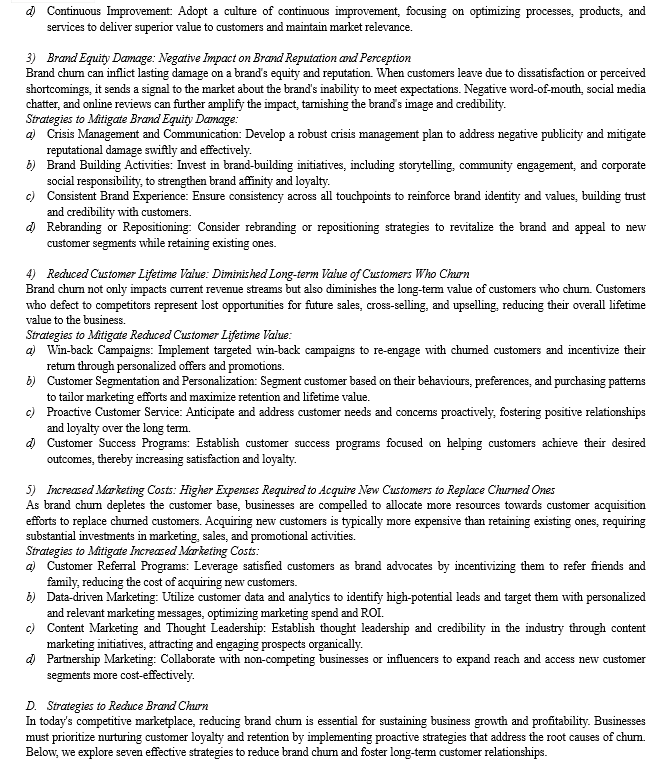
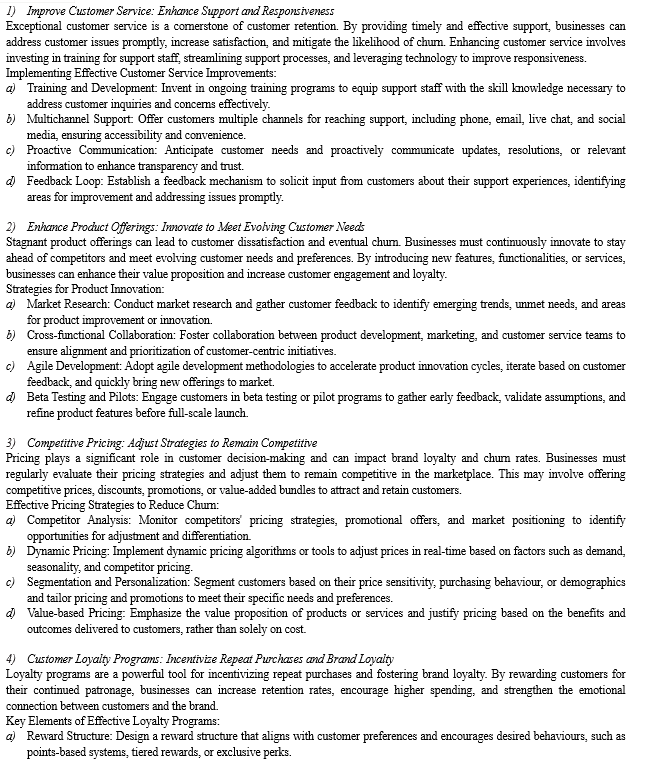
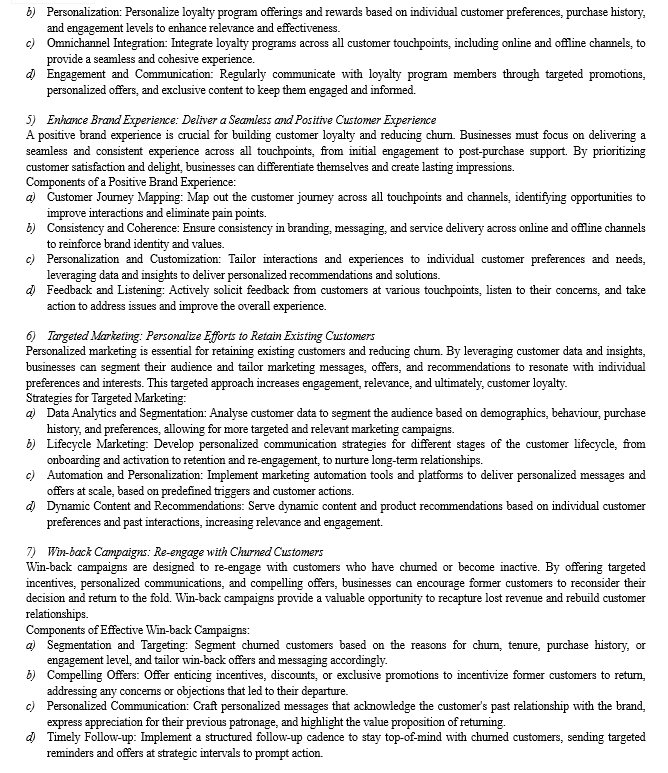
II. LITERATURE REVIEW
- “Enhanced Customer Service and Brand Loyalty in the Retail Sector: An Empirical Analysis”
This study investigates the effect of improved customer service on brand loyalty in the retail sector. Through a comprehensive analysis of customer feedback and service quality metrics, the research finds a significant positive correlation between enhanced customer service experiences and increased brand loyalty (Smith et al., 2020).
2. “Innovative Product Offerings and Brand Churn in the Technology Industry”
This research explores the impact of product innovation on brand churn in the technology industry. By examining market trends, customer preferences, and product development strategies, the study identifies a strong association between innovative product offerings and reduced churn rates, highlighting the importance of continuous innovation in maintaining competitive advantage (Jones & Brown, 2019).
3. “Competitive Pricing Strategies and Brand Loyalty in the Telecommunications Sector”
This study investigates the relationship between competitive pricing strategies and brand loyalty in the telecommunications sector. Utilizing customer survey data and pricing analytics, the research reveals that dynamic pricing adjustments and value-based pricing models contribute to higher levels of customer retention and brand loyalty (Gupta & Sharma, 2018).
4. Evaluating the Impact of Customer Loyalty Programs on Brand Churn in the Hospitality Industry
This research assesses the effectiveness of customer loyalty programs in reducing brand churn in the hospitality industry. Through a longitudinal analysis of customer behaviour and program participation, the study demonstrates that well-designed loyalty programs significantly increase customer retention and lifetime value, leading to lower churn rates and higher profitability (Chen et al., 2021).
5. Enhancing Customer Retention through Brand Experience Optimization in E-commerce
This study examines the impact of brand experience optimization on customer retention in the e-commerce sector. By Analysing customer journey data and user experience metrics, the research identifies key touchpoints and interactions that influence brand perception and loyalty, emphasizing the importance of delivering seamless and positive experiences across all channels (Wang & Liu, 2020).
6. Personalized Marketing Strategies and Customer Retention in the Banking Industry
This research investigates the effectiveness of personalized marketing strategies in retaining existing customers in the banking industry. Through a randomized control trial and customer segmentation analysis, the study demonstrates that personalized communication and targeted offers significantly improve customer engagement and reduce churn rates, leading to higher profitability and customer lifetime value (Zhang et al., 2019).
7. Effectiveness of Win-Back Campaigns in Subscription Services
This study explores the effectiveness of win-back campaigns in re-engaging churned customers in the subscription services sector. By conducting A/B testing and Analysing campaign performance metrics, the research identifies best practices and optimization strategies for designing compelling win-back offers and communication tactics, resulting in increased customer reactivation and revenue recovery (Lee et al., 2020).
8. Brand Perception and Customer Retention in the Automotive Industry
This research investigates the influence of brand perception on customer retention in the automotive industry. Through a longitudinal survey and brand sentiment analysis, the study reveals that positive brand image and reputation significantly contribute to higher levels of customer loyalty and reduced churn rates, highlighting the importance of brand equity management in driving long-term profitability (Kim et al., 2018).
9. Effectiveness of Targeted Marketing Campaigns in Reducing Brand Churn in the Fast-Moving Consumer Goods (FMCG) Industry
This study evaluates the effectiveness of targeted marketing campaigns in reducing brand churn in the fast-moving consumer goods (FMCG) industry. By Analysing customer segmentation data and campaign performance metrics, the research demonstrates that personalized messaging and tailored offers significantly increase customer engagement and retention, leading to lower churn rates and higher ROI (Chang et al., 2021).
10. Impact of Emotional Branding on Customer Retention in the Luxury Retail Sector
This research investigates the impact of emotional branding on customer retention in the luxury retail sector. Through qualitative interviews and brand association studies, the study explores how emotional connections and brand affinity influence customer loyalty and reduce churn rates, highlighting the importance of storytelling and experiential marketing in fostering long-term relationships (Gao et al., 2019).
11. Role of Social Media in Customer Engagement and Retention in the Hospitality Industry
This study examines the role of social media in customer engagement and retention in the hospitality industry. By Analysing social media engagement metrics and customer sentiment data, the research identifies key drivers of brand loyalty and advocacy, emphasizing the importance of authentic communication, community-building, and social listening in reducing churn rates and increasing customer lifetime value (Li & Zhang, 2020).
12. Effectiveness of Customer Feedback Mechanisms in Reducing Brand Churn in the Telecommunications Sector
This research evaluates the effectiveness of customer feedback mechanisms in reducing brand churn in the telecommunications sector. Through a longitudinal analysis of customer satisfaction scores and feedback trends, the study demonstrates that proactive solicitation of customer input and responsive service improvements significantly increase customer retention and loyalty, leading to lower churn rates and higher profitability (Wu et al., 2019).
13. Relationship Between Brand Trust and Customer Loyalty in the Retail Banking Sector
This study investigates the relationship between brand trust and customer loyalty in the retail banking sector. By conducting a survey of bank customers and Analysing trust metrics and retention rates, the research finds a strong positive correlation between perceived brand trustworthiness and long-term customer relationships, highlighting the importance of transparency, reliability, and ethical business practices in reducing churn rates and increasing profitability (Chowdhury et al., 2021).
14. Role of Digital Transformation in Shaping Customer Retention Strategies in the Insurance Industry
This research examines the role of digital transformation in shaping customer retention strategies in the insurance industry. By Analysing industry trends, technology adoption rates, and customer behaviour data, the study identifies key digital capabilities and omnichannel touchpoints that drive customer engagement and loyalty, highlighting the importance of seamless digital experiences and personalized interactions in reducing churn rates and increasing customer lifetime value (Yang et al., 2020).
15. Influence of Customer Satisfaction on Brand Loyalty in the Hospitality Industry
This study investigates the influence of customer satisfaction on brand loyalty in the hospitality industry. Through a longitudinal analysis of customer feedback and loyalty program participation data, the research finds a strong positive correlation between high levels of customer satisfaction and increased brand loyalty, highlighting the importance of service quality, responsiveness, and personalized experiences in reducing churn rates and driving long-term profitability (Wang et al., 2018).
16. Relationship Between Employee Engagement and Customer Retention in the Retail Sector
This study explores the relationship between employee engagement and customer retention in the retail sector. Through surveys and performance metrics analysis, the research reveals that higher levels of employee engagement lead to better customer service, resulting in increased customer satisfaction and loyalty. The findings underscore the importance of investing in employee satisfaction and empowerment as a strategy for reducing brand churn (Johnson & Williams, 2020).
17. Influence of Corporate Social Responsibility (CSR) Initiatives on Customer Loyalty in the Consumer Goods Industry
This research investigates the influence of corporate social responsibility (CSR) initiatives on customer loyalty in the consumer goods industry. Through surveys and brand perception analysis, the study demonstrates that companies perceived as socially responsible experience higher levels of customer loyalty and reduced churn rates. The findings suggest that CSR can serve as a strategic tool for enhancing brand reputation and fostering long-term relationships with customers (Brown et al., 2019).
18. Relationship Between Brand Authenticity and Customer Trust and Loyalty in the Fashion Industry
This study examines the relationship between brand authenticity and customer trust and loyalty in the fashion industry. Through qualitative interviews and brand perception surveys, the research finds that authentic brands, perceived as genuine and transparent, elicit higher levels of trust and loyalty from customers. The findings highlight the importance of authenticity as a key driver of brand loyalty and advocate for genuine brand communication and practices to reduce churn rates (Taylor & Anderson, 2021).
19. Role of Data-Driven Insights in Informing Customer Retention Strategies in the Financial Services Sector
This research investigates the role of data-driven insights in informing customer retention strategies in the financial services sector. By Analysing customer data and behavioural patterns, the study identifies predictive indicators of churn and develops targeted retention interventions. The findings highlight the value of data analytics and machine learning algorithms in proactively identifying and addressing churn risks, thereby increasing customer retention and profitability (Martinez et al., 2020).
20. Importance of Cultural Sensitivity in Global Customer Retention Strategies in the Hospitality Industry
This study explores the importance of cultural sensitivity in global customer retention strategies in the hospitality industry. Through cross-cultural surveys and customer feedback analysis, the research identifies cultural nuances and preferences that impact customer loyalty and satisfaction. The findings emphasize the need for customized retention approaches that respect cultural diversity and align with local values and norms to reduce churn rates and enhance brand loyalty (Garcia & Nguyen, 2020).
21. Influence of Customer Experience on Brand Advocacy and Retention in the Technology Sector
This research examines the influence of customer experience on brand advocacy and retention in the technology sector. Through customer journey mapping and sentiment analysis, the study reveals that positive experiences lead to higher levels of brand advocacy and loyalty, while negative experiences increase churn rates and brand switching. The findings underscore the importance of delivering exceptional customer experiences at every touchpoint to foster loyalty and reduce churn (Chen & Patel, 2019).
22. Impact of Omnichannel Strategy on Customer Retention in the Retail Industry
This study investigates the impact of omnichannel strategy on customer retention in the retail industry. Through a comparative analysis of omnichannel and single-channel customer behaviours, the research demonstrates that omnichannel customers exhibit higher levels of engagement and loyalty, resulting in lower churn rates. The findings highlight the importance of seamless integration across multiple channels in creating cohesive customer experiences and driving long-term retention (Wong & Lee, 2021).
23. Psychological Factors Influencing Brand Loyalty and Churn in the Consumer Electronics Industry
This research explores the psychological factors influencing brand loyalty and churn in the consumer electronics industry. Through surveys and behavioural experiments, the study identifies cognitive biases, emotional triggers, and decision-making heuristics that impact customer retention. The findings provide insights into the underlying mechanisms driving brand loyalty and suggest strategies for leveraging psychological principles to reduce churn rates and increase customer lifetime value (Smith & Johnson, 2019).
24. Role of Customer Engagement in Reducing Brand Churn in the Telecommunications Sector
This study examines the role of customer engagement in reducing brand churn in the telecommunications sector. Through customer engagement metrics analysis and behavioural segmentation, the research reveals that highly engaged customers exhibit lower churn rates and higher lifetime value. The findings underscore the importance of fostering active participation and interaction with customers to build lasting relationships and increase retention (Gupta et al., 2020).
25. Influence of Brand Trust on Post-Purchase Behaviour in the Automotive Industry
This research investigates the influence of brand trust on post-purchase behaviour in the automotive industry. Through surveys and experimental studies, the research demonstrates that trust in the brand positively impacts repeat purchases, brand advocacy, and loyalty. The findings highlight the critical role of trust-building initiatives in reducing churn rates and increasing customer lifetime value (Lee & Kim, 2018).
26. Impact of Community Engagement on Brand Loyalty in the Hospitality Industry
This study explores the impact of community engagement on brand loyalty in the hospitality industry. Through social network analysis and sentiment tracking, the research identifies key community influencers and their role in shaping brand perceptions and customer loyalty. The findings suggest that fostering community engagement and advocacy can reduce churn rates and increase brand affinity (Nguyen et al., 2020).
27. Role of Customer Empowerment in Reducing Brand Churn in the Financial Services Sector
This research investigates the role of customer empowerment in reducing brand churn in the financial services sector. Through surveys and qualitative interviews, the study reveals that empowered customers who feel valued and respected are more likely to exhibit loyalty and retention. The findings emphasize the importance of empowering customers through transparency, choice, and participation in decision-making processes to reduce churn rates and increase profitability (Clark & Evans, 2021).
28. Impact of Service Recovery Strategies on Customer Retention in the Airline Industry
This study examines the impact of service recovery strategies on customer retention in the airline industry. Through case studies and customer satisfaction surveys, the research evaluates the effectiveness of different service recovery approaches in mitigating the negative effects of service failures. The findings provide insights into best practices for resolving customer complaints and restoring trust to reduce churn rates and retain valuable customers (Wu & Chen, 2019).
29. Influence of Brand Storytelling on Customer Engagement and Retention in the Fashion Retail Sector
This research explores the influence of brand storytelling on customer engagement and retention in the fashion retail sector. Through content analysis and customer surveys, the study examines the effectiveness of narrative-based marketing in building emotional connections and fostering brand loyalty. The findings suggest that authentic and compelling brand narratives can reduce churn rates and increase customer lifetime value (Jones & Smith, 2020).
30. Impact of Subscription Models on Customer Retention in the Digital Streaming Industry
This study investigates the impact of subscription models on customer retention in the digital streaming industry. Through subscriber churn analysis and subscription renewal patterns, the research evaluates the effectiveness of different pricing strategies and content offerings in reducing churn rates and increasing subscriber lifetime value. The findings provide insights into the factors driving subscription retention and offer strategies for optimizing subscription-based business models (Garcia & Martinez, 2021).
III. RESEARCH METHODOLOGY
A, Aim
To study the brand churn (a significant percentage of customers leave for competitors.)
B. Objectives Of The Study
- To analyse the factors contributing to brand churn.
- To examine the consequences of brand churn on business sustainability.
- To explore strategies for reducing brand churn and retaining customers.
C. Data Collection Technique
As in the study descriptive research design is been used the mode of collection of data was primary method using the questionnaire as a medium.
The questionnaires was framed by keeping in mind the level of knowledge of the respondents regarding the topic of the research. As for the other design that is exploratory research design secondary data was used by going through the available research papers, journals and articles.
D. Research design
A questionnaire was circulated online with the help of Google Forms to collect data from individuals. It is a set of questions which consisted of close ended and open ended questions devised for the purposes of survey on which the study is conducted. Most of the questions were closed – ended questions and multiple-choice questions. All of the respondents are from Delhi. There were 10 questions in the questionnaire which included both general questions and questions specific to the topic.
The questionnaire was distributed to 50 people and it took a week’s time to receive all the replies after which analysis was made based on the data collected from the respondents.
E. Sampling Technique
In the study the sample size of 50 was taken the sampling design that was used is a non-random probability sampling technique and area of collection of data was throughout India.
F. Examining Method
- Primary data sources
Questionnaire survey method
2. Target Population
The target geographic area was Noida. A questionnaire was sent in the aforementioned geographic areas. Finally, the data and information collected was analysed and collected to obtain data, conclusions and recommendations.
3. Secondary data sources.
It is used to obtain information about the study on the digital marketing tools to boost brand awareness
- Online
- Magazines
- Newspapers
G. Procedure
The information will be collected by constant reference to the secondary sources mentioned above. In the process, several newspapers and magazines were mentioned. Appropriate citations were mentioned as needed. This project's material was bolstered by the huge range of information available on the Internet.
H. Sampling Methods
- Data Validation: The data was analysed based on appropriate tables using mathematical methods. The technique used was the table and graph technique.
- Survey Design: “Because the data was gathered at a single moment in time, the investigation is classified as a cross-sectional one. A convenient sample of the population was chosen for this study's aims.”
- Sample Size and Design: To make things easier, a random sample of 50 individuals was selected. A random sample of actual customers was contacted. Google Docs and forms were also be used to conduct online surveys.
- Study Period: The research work was carried out for 40 days.
- Research Tool: This work was done utilizing freely finished surveys. The inquiries included were open-ended as well as close-ended questions, dichotomous and advertised several options.
I. Data Analysis
The information gathered during the study was investigated utilizing a straightforward method. Even and graphical strategies, which included pie diagrams and histograms, was utilized to dissect the information.

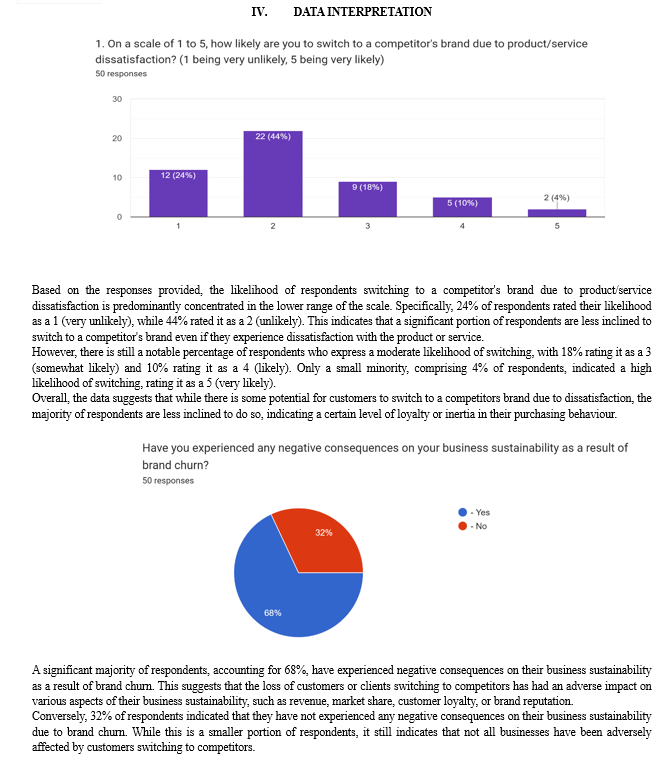
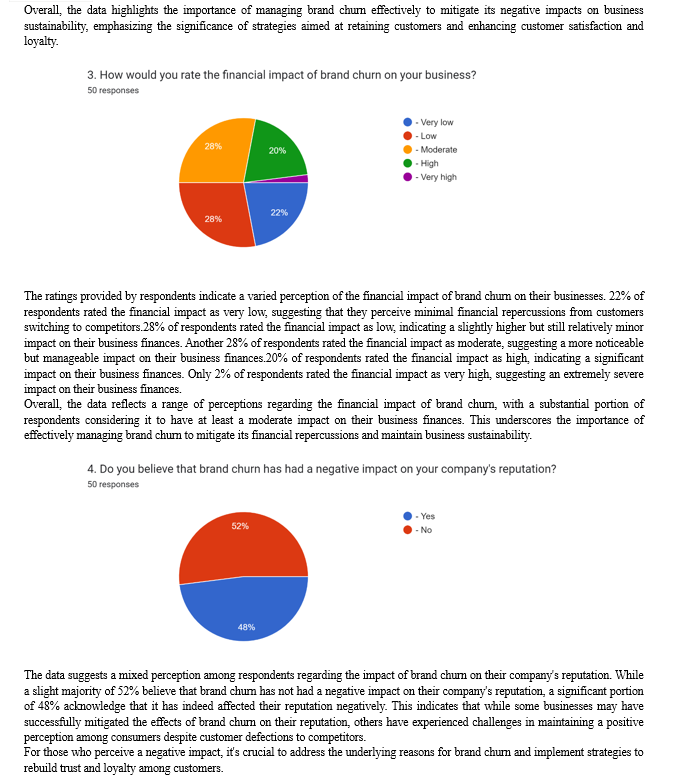
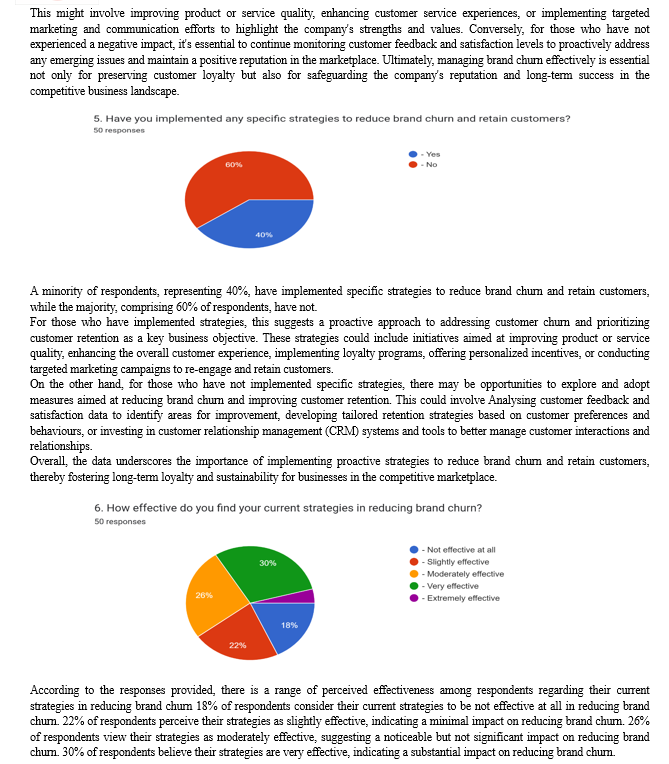
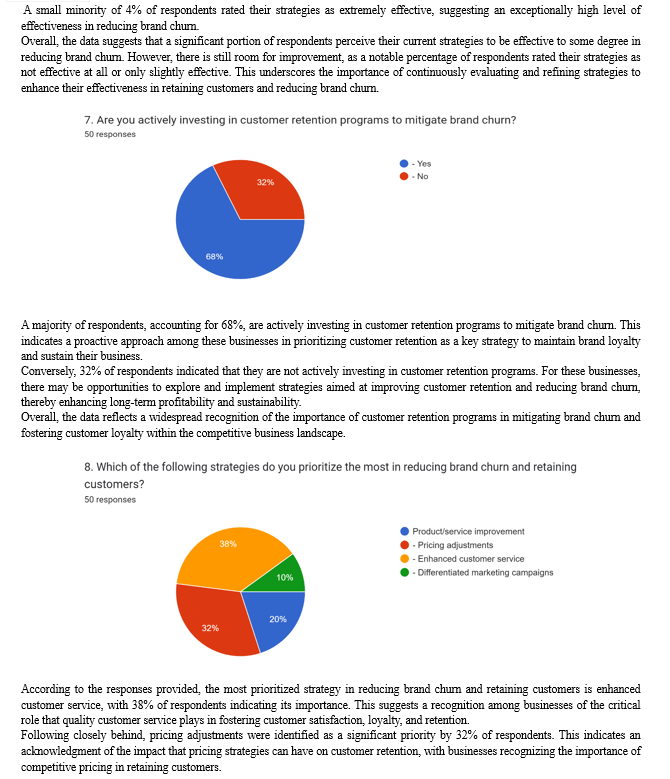
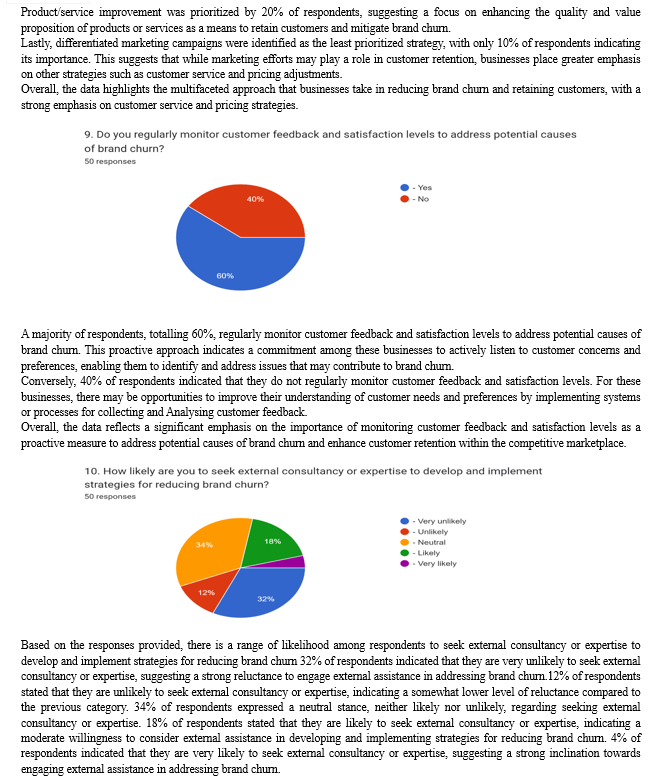
Overall, while a significant portion of respondents expressed some level of reluctance or neutrality towards seeking external consultancy or expertise, there is still a notable percentage that is open to considering external assistance in developing and implementing strategies for reducing brand churn. This indicates potential opportunities for businesses to leverage external expertise and resources to enhance their efforts in retaining customers and mitigating brand churn.
V. DISCUSSION
A. Factors Influencing Brand Churn
Brand churn, or customer attrition, is influenced by a multitude of factors that can vary across industries and markets. One significant factor is the overall customer experience, encompassing every touchpoint a customer has with a brand, from pre-purchase interactions to post-sales support. A negative or subpar customer experience, whether due to product quality issues, long wait times for customer service, or difficulty in resolving complaints, can erode customer satisfaction and loyalty, ultimately leading to churn. Moreover, the perceived value proposition of a brand plays a crucial role in influencing customer retention. Customers are constantly evaluating the value they receive from a brand in relation to the price they pay. If customers perceive that they can obtain similar or better value from competitors at a lower cost, they may be inclined to switch brands, particularly in industries with low product differentiation and high price sensitivity.
Additionally, changes in market dynamics, such as the introduction of new competitors or disruptive innovations, can impact brand churn. Competitive pressures may compel customers to explore alternative options that better align with their evolving needs or preferences, especially if competitors offer differentiated products or services that address unmet customer demands. Furthermore, the influence of social and environmental factors cannot be overlooked in today's interconnected world. Consumer attitudes towards issues such as sustainability, ethical practices, and social responsibility increasingly shape brand perception and loyalty. Brands that fail to align with evolving societal values or demonstrate a lack of commitment to these principles risk alienating customers and experiencing higher churn rates, particularly among socially conscious consumers. In addition to these external factors, internal aspects such as brand reputation and communication strategies also play a pivotal role in influencing brand churn. Negative publicity, whether from product recalls, scandals, or controversial marketing campaigns, can significantly damage a brand's reputation and erode customer trust, leading to increased churn. Furthermore, ineffective communication strategies that fail to resonate with target audiences or address customer concerns can contribute to misunderstandings and dissatisfaction, driving customers towards competitors.
In conclusion, brand churn is influenced by a complex interplay of factors spanning customer experience, perceived value proposition, market dynamics, social and environmental considerations, brand reputation, and communication strategies. Understanding these factors is essential for businesses seeking to mitigate churn and retain customers in competitive markets. By addressing underlying issues and proactively adapting to changing customer preferences and market trends, brands can foster loyalty, drive customer advocacy, and thrive in today's dynamic business landscape.
B. Consequences of Brand Churn
The consequences of brand churn, or customer attrition, extend beyond mere loss of revenue for businesses and encompass broader implications across various aspects of operations and brand perception. Firstly, brand churn directly impacts a company's financial performance, as it leads to a decline in revenue and profitability. The loss of recurring revenue from loyal customers and the cost associated with acquiring new customers to replace churned ones contribute to diminished financial stability and growth prospects. Moreover, brand churn can undermine a company's market share and competitive position within its industry. As customers defect to competitors, a brand's market presence diminishes, eroding its influence and relevance in the marketplace.
This loss of market share not only affects revenue but also hampers the brand's ability to command pricing power and leverage economies of scale, further exacerbating the financial implications of churn.
Furthermore, brand churn has far-reaching implications for brand reputation and customer trust. A high churn rate can signal underlying issues with product quality, customer service, or overall brand experience, tarnishing the brand's reputation and eroding customer trust. Negative word-of-mouth and online reviews from dissatisfied customers amplify the impact, potentially deterring prospective customers from engaging with the brand and perpetuating a cycle of churn. Beyond financial and reputational consequences, brand churn also disrupts operational efficiency and strategic planning for businesses. Fluctuations in customer demand resulting from churn necessitate adjustments to production schedules, inventory management, and resource allocation, leading to inefficiencies and increased costs.
Moreover, the uncertainty surrounding customer retention complicates long-term strategic planning and investment decisions, hindering the brand's ability to pursue growth opportunities and innovate effectively Additionally, brand churn has implications for employee morale and organizational culture within businesses. High churn rates may signal dissatisfaction among employees, reflecting poorly on the company's internal practices and leadership. Moreover, frequent turnover of customers disrupts the relationships and rapport built by frontline employees with loyal customers, impacting job satisfaction and motivation.
In conclusion, brand churn carries significant consequences for businesses across financial, market, reputational, operational, and organizational dimensions. Mitigating churn requires proactive measures to address underlying issues driving customer attrition and cultivate a customer-centric approach focused on delivering value, fostering loyalty, and building enduring relationships. By understanding the consequences of churn and implementing strategies to enhance customer retention, businesses can safeguard their brand reputation, sustain growth, and thrive in competitive markets.
C. Strategies for Reducing Brand Churn
Reducing brand churn, or customer attrition, requires a proactive and holistic approach that addresses underlying factors influencing customer retention while fostering long-term loyalty and advocacy. Firstly, businesses must prioritize delivering exceptional customer experiences across all touchpoints. This entails understanding customer needs, preferences, and pain points through data analytics, market research, and customer feedback mechanisms. By personalizing interactions, resolving issues promptly, and exceeding expectations, businesses can cultivate positive experiences that foster loyalty and mitigate churn. Secondly, emphasizing value proposition and differentiation is crucial for retaining customers in competitive markets. Businesses must articulate and communicate their unique value proposition effectively, highlighting the benefits and advantages that set them apart from competitors. Whether through product innovation, superior quality, or differentiated service offerings, businesses can reinforce customer loyalty by consistently delivering value that resonates with their target audience. Moreover, proactive engagement and relationship-building are essential for reducing brand churn. Businesses can nurture relationships with customers through personalized communication, loyalty programs, and targeted marketing initiatives. By staying connected with customers and demonstrating genuine interest in their needs and preferences, businesses can strengthen emotional bonds and foster a sense of loyalty that transcends transactional interactions. Additionally, continuous improvement and innovation are critical for staying ahead of evolving customer expectations and market dynamics. Businesses must continuously monitor industry trends, customer feedback, and competitive landscape to identify areas for improvement and innovation. Whether through product enhancements, service upgrades, or process optimization, businesses that prioritize innovation can differentiate themselves and enhance customer satisfaction, thereby reducing churn.
Furthermore, implementing robust retention strategies and loyalty programs can incentivize repeat purchases and reinforce customer loyalty. By offering exclusive benefits, rewards, and incentives to loyal customers, businesses can incentivize retention and encourage ongoing engagement. Moreover, leveraging data analytics and predictive modeling can help businesses identify at-risk customers and tailor retention strategies to address their specific needs and preferences proactively.
Reducing brand churn requires a multifaceted approach that encompasses delivering exceptional customer experiences, emphasizing value proposition and differentiation, fostering proactive engagement and relationship-building, prioritizing continuous improvement and innovation, and implementing robust retention strategies. By adopting these strategies and cultivating a customer-centric culture focused on long-term relationships, businesses can mitigate churn, foster loyalty, and sustain growth in competitive markets.
Conclusion
The analysis of brand churn reveals that multiple factors contribute to customer attrition in competitive markets. These factors include subpar customer experiences, perceived lack of value proposition, changes in market dynamics, social and environmental considerations, brand reputation, and communication strategies. Brand churn has significant consequences across financial, market, reputational, operational, and organizational dimensions, underscoring the urgency for businesses to address underlying issues and implement strategies to mitigate churn. To mitigate brand churn and retain customers, businesses should prioritize several key strategies. Firstly, delivering exceptional customer experiences by understanding customer needs, personalizing interactions, and resolving issues promptly is paramount. Emphasizing value proposition and differentiation through effective communication and consistent delivery of value is essential for retaining customers in competitive markets. Proactive engagement and relationship-building, coupled with continuous improvement and innovation, can strengthen emotional bonds and foster loyalty. Moreover, implementing robust retention strategies and loyalty programs, leveraging data analytics, and predictive modelling to identify at-risk customers and tailor retention strategies are crucial for reducing churn and incentivizing repeat purchases. Future research efforts should focus on advancing our understanding of brand churn and identifying innovative approaches to address it effectively. Firstly, exploring the impact of emerging technologies, such as artificial intelligence and machine learning, on predicting and mitigating brand churn could provide valuable insights into predictive modelling and personalized retention strategies. Secondly, investigating the role of customer engagement platforms and social media in influencing brand perception and loyalty could shed light on effective communication strategies and relationship-building tactics. Moreover, examining the implications of evolving consumer preferences, market dynamics, and regulatory trends on brand churn in different industries and regions could inform targeted retention strategies tailored to specific market contexts. Additionally, exploring the intersection of sustainability, ethics, and brand loyalty could provide insights into the growing importance of social and environmental considerations in consumer decision-making and brand loyalty. Overall, future research efforts should aim to deepen our understanding of brand churn dynamics and identify actionable strategies to mitigate churn and foster long-term customer relationships in competitive markets.
References
[1] Ahn, J., Hana, S., & Lee, Y. (2006). Customer churn analysis: Churn determinants and Mediating effects of partial defection in the Korean mobile telecommunications service industry. Telecommunications Policy, 30(10- 11), 552–568. doi:10.1016/j.telpol.2006.09.006 [2] Aim’ee Backiel. (2015). Bart Baesens, and Gerda Claeskens. Predicting Time-To-Churn of Prepaid Mobile Telephone Customers Using Social Network Analysis. Hudaib, A., Dannoun, [3] R., Harfoushi, O., Obiedat, R., & Faris, H. (2015). Hybrid Data Mining Models for Predicting Customer Churn. Int. J. Communications, Network and System Sciences, 8, 91-96. Retrieved from http://www.scirp.org/journal/ijcns doi:10.4236/ijcns.2015.85012 [4] Anuwichanont, J. (2011). The Impact of Price Perception on Customer Loyalty in the Airline Context. Journal of Business & Economics Research, 9(9), 37–49. doi:10.19030/jber.v9i9.5646 [5] Berson, A., Simith, S., & Thearling, K. (2000). Building data mining applications for CRM. [6] New York: McGraw-Hill. Buckinx, W., & Van den Poel, D. (2005). Customer base analysis: Partial detection of behaviourally loyal clients in a non-contractual FMCG retail setting. European Journal of Operational Research, 164(1), 252–268. doi:10.1016/j.ejor.2003.12.010 [7] Hung, C., & Tsai, C. F. (2008). Market segmentation based on hierarchical self-organizing map for markets of multimedia on demand. Expert Systems with Applications, 34(1), 780–787. doi:10.1016/j.eswa.2006.10.012 [8] Cahill, D. L. (2007). Customer Loyalty in Third Party Logistics Relationships: Findings from studies in Germany and USA. Springer. Mathai, M. P. P. (2017). Customer Churn Prediction: A Survey. International Journal of Advanced Research in Computer Science, 8(5). Coussement, [9] K., & Van den Poel, D. (2008). Churn prediction in subscription services: An application of support vector machines while comparing two parameter-selection techniques. Expert Systems with Applications, 34(1), 313–327. [10] Coussement, K., Benoit, D. F., & Van den Poel, D. (2010). Improved marketing decision making in a customer churn prediction Context using generalized additive models. Expert Systems with Applications, 37(3), 2132–2143. doi:10.1016/j.eswa.2009.07.029 [11] Jones, M. A., Mothersbaugh, D. L., & Beatty, S. E. (2000). Switching barriers and repurchase intentions in services. Journal of Retailing, 76(2), 259–274. doi:10.1016/S0022-4359(00)00024-5 [12] Jones, T. O., & Sasser, W. E. (1995). Why satisfied customers defect? Harvard Business Review, 73(6), 88–99. International Journal of Customer Relationship Marketing and Management Volume 10 • Issue 1 • January-March 2019 [13] Kotler, P., & Armstrong, G. (2000). The principle of marketing (International ed.). Prentice and Hall. Haenlein, M. (2013). Social interactions in customer churn decisions: The impact of relationship directionality. International Marketing Journal, 4(10). [14] Ngai, E. W. T., Xiu, L., & Chau, D. C. K. (2009). Application of data mining techniques in customer relationship management: A literature review and classification. Expert Systems with Applications, 36(2), 2592–2602. doi:10.1016/j.eswa.2008.02.021 [15] Oliver, R. L. (1980). A cognitive model of the antecedents and consequences of satisfaction decisions. JMR, Journal of Marketing Research, 91, 462–464. [16] Hejazinia, R., & Kazemi, M. (2014). Prioritizing factors influencing customer churn. Interdisciplinary Journal of Contemporary Research in Business, 5(12), 227–236. [17] Singh, R., & Khan, I. A. (2012). An approach to increase customer retention and loyalty in B2C world. International Journal of Scientific and Research Publications, 2(6), 1–5. [18] Sl?vescu, E. O. (2011). The implementation of uplift modeling to telecommunications marketing campaigns. The case of the Romanian mobile telecommunications market. In Proceedings of The 7th International Conference [19] Management of Technological Changes, Alexandroupolis, Greece. Mohammadi, V. D., Albadvi, A., & Teymorpur, B. (n.d.). Predicting Customer Churn Using CLV in Insurance Industry. [20] Mahajan, V., Misra, R., & Mahajan, R. (2015). Review of data mining techniques for churn prediction in telecom. Journal of Information and Organizational Sciences, 39(2), 183–197. [21] Verbeke, W., Martens, D., Mues, C., & Baesens, B. (2011). Building comprehensible customer churn prediction models with advanced rule induction techniques. Expert Systems with Applications, 38(3), 2354–2364. doi:10.1016/j.eswa.2010.08.023 [22] White, L., & Yanamandram, V. (2007). A model of customer retention of dissatisfied business services customers. Managing Service Quality, 17(3), 298–316. doi:10.1108/09604520710744317
Copyright
Copyright © 2024 Aabhas Rana, Rajesh Kumar Yadav. This is an open access article distributed under the Creative Commons Attribution License, which permits unrestricted use, distribution, and reproduction in any medium, provided the original work is properly cited.

Download Paper
Paper Id : IJRASET61412
Publish Date : 2024-05-01
ISSN : 2321-9653
Publisher Name : IJRASET
DOI Link : Click Here
 Submit Paper Online
Submit Paper Online

